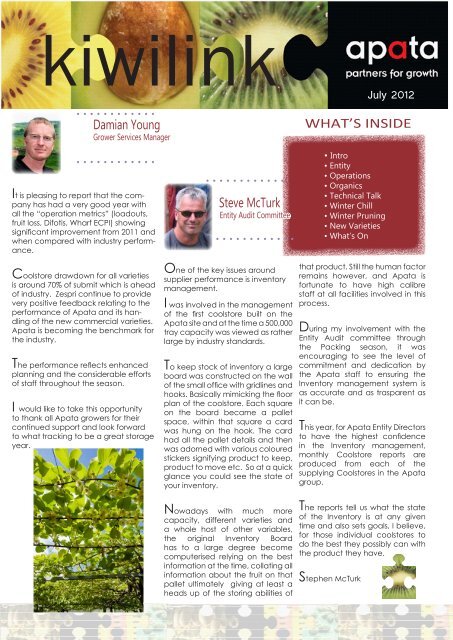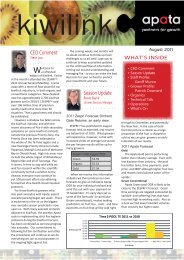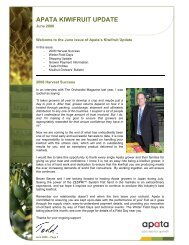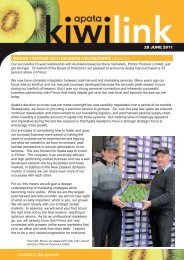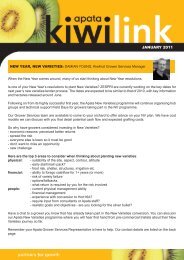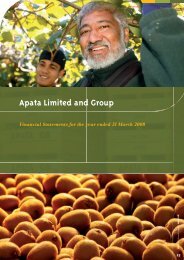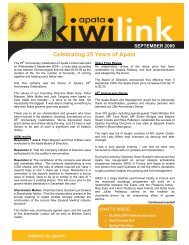What's inside July 2012 Steve McTurk Damian Young - Apata
What's inside July 2012 Steve McTurk Damian Young - Apata
What's inside July 2012 Steve McTurk Damian Young - Apata
Create successful ePaper yourself
Turn your PDF publications into a flip-book with our unique Google optimized e-Paper software.
kiwilink<br />
<strong>Damian</strong> <strong>Young</strong><br />
Grower Services Manager<br />
It is pleasing to report that the company<br />
has had a very good year with<br />
all the “operation metrics” (loadouts,<br />
fruit loss, Difotis, Wharf ECPI) showing<br />
significant improvement from 2011 and<br />
when compared with industry performance.<br />
Coolstore drawdown for all varieties<br />
is around 70% of submit which is ahead<br />
of industry. Zespri continue to provide<br />
very positive feedback relating to the<br />
performance of <strong>Apata</strong> and its handling<br />
of the new commercial varieties.<br />
<strong>Apata</strong> is becoming the benchmark for<br />
the industry.<br />
The performance reflects enhanced<br />
planning and the considerable efforts<br />
of staff throughout the season.<br />
I would like to take this opportunity<br />
to thank all <strong>Apata</strong> growers for their<br />
continued support and look forward<br />
to what tracking to be a great storage<br />
year.<br />
<strong>Steve</strong> <strong>McTurk</strong><br />
Entity Audit Committee<br />
One of the key issues around<br />
supplier performance is inventory<br />
management.<br />
I was involved in the management<br />
of the first coolstore built on the<br />
<strong>Apata</strong> site and at the time a 500,000<br />
tray capacity was viewed as rather<br />
large by industry standards.<br />
To keep stock of inventory a large<br />
board was constructed on the wall<br />
of the small office with gridlines and<br />
hooks. Basically mimicking the floor<br />
plan of the coolstore. Each square<br />
on the board became a pallet<br />
space, within that square a card<br />
was hung on the hook. The card<br />
had all the pallet details and then<br />
was adorned with various coloured<br />
stickers signifying product to keep,<br />
product to move etc. So at a quick<br />
glance you could see the state of<br />
your inventory.<br />
Nowadays with much more<br />
capacity, different varieties and<br />
a whole host of other variables,<br />
the original Inventory Board<br />
has to a large degree become<br />
computerised relying on the best<br />
information at the time, collating all<br />
information about the fruit on that<br />
pallet ultimately giving at least a<br />
heads up of the storing abilities of<br />
<strong>July</strong> <strong>2012</strong><br />
What’s <strong>inside</strong><br />
• Intro<br />
• Entity<br />
• Operations<br />
• Organics<br />
• Technical Talk<br />
• Winter Chill<br />
• Winter Pruning<br />
• New Varieties<br />
• What’s On<br />
that product. Still the human factor<br />
remains however, and <strong>Apata</strong> is<br />
fortunate to have high calibre<br />
staff at all facilities involved in this<br />
process.<br />
During my involvement with the<br />
Entity Audit committee through<br />
the Packing season, it was<br />
encouraging to see the level of<br />
commitment and dedication by<br />
the <strong>Apata</strong> staff to ensuring the<br />
Inventory management system is<br />
as accurate and as trasparent as<br />
it can be.<br />
This year, for <strong>Apata</strong> Entity Directors<br />
to have the highest confidence<br />
in the Inventory management,<br />
monthly Coolstore reports are<br />
produced from each of the<br />
supplying Coolstores in the <strong>Apata</strong><br />
group.<br />
The reports tell us what the state<br />
of the Inventory is at any given<br />
time and also sets goals, I believe,<br />
for those individual coolstores to<br />
do the best they possibly can with<br />
the product they have.<br />
Stephen <strong>McTurk</strong>
Operational Update<br />
Turntable Rd Site<br />
The Turntable Road team has settled into a daily<br />
routine of condition checking, repacking, hi-cubing,<br />
market specific repacks and re-labeling. Fruit quality<br />
is exceptionally good this year and confidence in<br />
the Turntable Rd Quality Systems has been restored<br />
with continuing container and wharf audits meeting<br />
ZESPRI specification.<br />
<strong>Apata</strong>’s handling of New Commercial Varieties is<br />
being held as an example to the Industry.<br />
Conventional Coolstores.<br />
• All varieties are storing well with no problems<br />
to date<br />
• Condition checking has now commenced<br />
for all varieties.<br />
• There has been no rework required for the<br />
G3, G9 or G14 varieties.<br />
• Fruit Loss as % of Submit is less than Industry<br />
average for all categories.<br />
• All GK1CK will be loaded out by week 34.<br />
• The average fruit pressure for HW1CK library<br />
trays range from 3.1kgf to 5.5 kgf.<br />
• Coolstore drawdown is better than or similar<br />
to Industry average across Green, Gold,<br />
Organics and NCV.<br />
Ca Packing<br />
The first short term CA room was packed out in week<br />
25 with packouts/reject rates commensurate with UFI<br />
assessment. Two long term rooms containing 143,000<br />
trays will be packed in early August, subject to Zespri<br />
shipping schedule.<br />
Whangarei Site<br />
Gerry Hardie<br />
<strong>Apata</strong> Operations<br />
Manager<br />
We did our first repack last week. The gold storage<br />
results are very pleasing to date. The majority of gold<br />
remaining are 33 count. Hayward storage is also looking<br />
good. Shipped to date - GK 67.9% - HW 35.9%.<br />
Andrew Wood<br />
<strong>Apata</strong> Pyes Pa Manager<br />
<strong>Apata</strong> Organics<br />
Organic Category Report<br />
With the harvest now well behind us, attention has<br />
been very focused on the inventory management of the<br />
organic crop. We are very pleased with fruit performan<br />
ce to date however, we have been watching<br />
Week 22 – 23 inventory closely as this fruit has been<br />
indicating poorer storage ability. Currently we have<br />
loaded out 65% of the HWOB inventory and have a fruit<br />
loss of 0.4%. This fruit loss is slightly higher than industry at<br />
this stage but we are confident that we are in a strong<br />
position to complete the season with a great result.<br />
the GKOB inventory is now all on order and shipping will<br />
be completed within the next 10 days. Fruit loss for our<br />
GKOB category is currently 0.3% which is an outstanding<br />
result and a credit to both growers and inventory managers.<br />
i have visited a number of growers to look at<br />
the winter pruning and it is great to see an increased<br />
focus on bud numbers and cane<br />
selection. Winter is the key starting point to<br />
determine your crop at harvest next season. A<br />
lack of emphasis on bud numbers and wood<br />
selection at this time of year will have a<br />
detrimental effect on your results next harvest.<br />
Note from the Acting General Manager<br />
- Graeme Munro<br />
It is with regret I announce the resignation of Andrew<br />
Wood from his position of Organic Category & Pyes Pa<br />
Site Manager effective from Friday 20 <strong>July</strong> <strong>2012</strong>.<br />
Andrew has been with <strong>Apata</strong> since October 2008 and<br />
has been instrumental in promoting the Organic category<br />
both at <strong>Apata</strong> and across the industry.<br />
The company wishes Andrew all the best in his future<br />
endeavours and thanks Andrew for his contribution to the<br />
business.<br />
Submit Shipped %Shipped %Industry %loss over<br />
cooled<br />
HWCK 2,759,164 1,569,764 56.92% 47.8% 0.00%<br />
HWOB 1,254,285 825,040 65.78% 54.8% 0.31%<br />
HECK 13,118 9,822 79.87% 81.3% 0.00%<br />
GKCK 1,432,407 1,108,654 77.40% 75.8% 0.16%<br />
GKOB 141,257 140,257 99.29% 96.5% 0.00%<br />
GACK 98,144 72,671 74.25% 64.6% 0.00%<br />
GLCK 135,141 64,186 53.27% 58.3% 0.02%
Wade Hunkin<br />
Technical Talk<br />
<strong>Apata</strong> Technical Advisor<br />
PSA Statistics - 18 <strong>July</strong> <strong>2012</strong> PSA-V +<br />
Orchards 1239<br />
% of NZ orchards 38%<br />
Ha of affected orchards* 6446<br />
% of NZ Hectares on affected orchards 47%<br />
Whilst the confirmed cases of PSA-V are on the increase in New Zealand, I can confirm that PSA does not<br />
appear to be infecting Swiss kiwifruit. During a recent holiday I spotted these two plants growing in a<br />
garden next to Lake Constance. The pruning left a bit to be desired though.<br />
On a more pertinent note, there seemed to be plenty of New Zealand kiwifruit in the shops and on the<br />
hotel tables. We tested quite a bit and it all appeared in good condition. The only niggle was that<br />
Australian kiwifruit seemed to be getting a higher price than New Zealand kiwifruit.<br />
Winter Symptoms PSA<br />
I encourage all <strong>Apata</strong> growers to be vigilant in the<br />
monitoring of their orchard to ensure early detection of<br />
Psa infected vines and orchards.<br />
Spring and Autumn are considered higher risk infection<br />
periods but what we are seeing is the continual spread<br />
of Psa. We are receiving information on finds in the Te<br />
Puna – Plummers Point and Tauriko areas. Growers are<br />
strongly encouraged to regularly monitor their orchards<br />
and report suspicious findings to their Grower rep.<br />
Best orchard practices is to have a good monitoring<br />
strategy in place for early detection of Psa-V<br />
symptoms. Absence of obvious symptoms does<br />
not necessarily mean absence of Psa-V. Even if no<br />
symptoms are found, continue with regular monitoring.<br />
Identifying any changes in the level or degree of<br />
symptoms is key to rapid response in the event of an<br />
incursion.
Winter Chilling<br />
<strong>Damian</strong> <strong>Young</strong><br />
Kiwifruit Grower<br />
Services Manager<br />
The Hicane season is nearly upon us. Now is the time to<br />
start making decisions on timing and forming a plan with<br />
your spray contractor to ensure that you have the best<br />
possible chance of application at the optimum time.<br />
We know that winter chilling has a major impact on the<br />
budbreak and at this stage of the winter we have had a great<br />
chilling season. Below is some information that may help you<br />
with your decision making process if not the <strong>Apata</strong> grower reps<br />
are a great source of information and are available for advice.<br />
What is Winter Chilling?<br />
The amount of cold needed by a plant to resume normal spring<br />
growth following the winter period is commonly referred to as it’s<br />
“chilling requirement.”<br />
What Happens During Winter Chilling?<br />
During the Autumn and Winter deciduous fruit plants enter a<br />
dormant phase which is generally referred to as the plants’<br />
“dormant period.” Plants enter the dormant period in the<br />
Autumn as air temperatures begin to drop below 10°C, leaf fall<br />
occurs, and visible growth ceases. Another less visible change<br />
takes place as well. Plants enter the dormant, or rest, period as<br />
the level of growth-regulating chemicals in buds changes. In<br />
other words, as the growth-regulating inhibitors increase and the<br />
growth-regulating promoters decrease, plants begin their dormant<br />
period. As the chilling requirement of a plant is being satisfied by<br />
cold temperatures, the level of promoters begins increasing while<br />
the level of inhibitors decreases. The higher levels of<br />
promoters in the buds allow normal resumption of growth and<br />
flowering in the spring as the chilling requirement is met this all means<br />
hopefully better bud break.<br />
Year to date temperature and chilling<br />
Year May June<br />
<strong>2012</strong> 11.5 9.8<br />
2011 13.6 12.7<br />
2010 101.5 9.8<br />
2009 9.1 7.9<br />
2008 9.6 9.7<br />
2007 12.1 9.5<br />
2006 11.4 7.3<br />
Chilling measurements explained<br />
Hours Below Threshold (7°C)<br />
This is the most commonly used measure of<br />
winter chill in New Zealand. It assumes that the<br />
tree or plant receives no chilling effect<br />
when the temperatures are above the base<br />
temperature of 7°C, and that temperatures below<br />
7°C all contribute equal chilling effect. Therefore for<br />
every hour below 7°C, one hour of chilling is recorded.<br />
Chilling Hours<br />
Based on the same concept as Hours Below<br />
Threshold, except that it is assumed that the<br />
colder the temperatures then the greater the<br />
chilling effect. So with a threshold temperature<br />
of 7°C, one hour at 6°C is one chill hour; one<br />
hour at 5°C is two chill hours etc. One fairly common<br />
variation that you may see on both Hours Below<br />
Threshold and Chilling Hours is to assume that<br />
temperatures below 0°C give no chilling effect.
Richardson Chill Units<br />
Originally developed using potted trees in controlled<br />
temperature rooms, the Richardson Chill<br />
Unit tries to better estimate the chilling effect of<br />
various temperatures. The optimum for chilling<br />
was found to be 4°C, and so one hour at 4°C counts<br />
as one Richardson Chill Unit. Chilling effect falls<br />
away to zero as the temperature approaches 0°C,<br />
and falls away at higher temperatures with no chill<br />
effect at temperatures over 14°C. There are many<br />
refinements available to the Richardson Chill Unit<br />
including negation of chilling by temperatures<br />
over 14°C, and fixation of chilling effect<br />
against high temperature negation over time.<br />
Richardson Chill Units <strong>2012</strong><br />
May June <strong>July</strong> to Date Total<br />
Te Puke 246 383 248 877<br />
Katikati 239 276 202 717<br />
Whangarei no data available<br />
(Information provided by Hortnet.harvest.com)<br />
What does this mean?<br />
Hayward<br />
We expect the budbreak to be early this year with a<br />
predicted average to high floral response, along with a<br />
higher than average budbreak. Applications of Hicane<br />
should be earlier than last year (30-35 days before<br />
budbreak). Last year the optimum date for<br />
mid-altitude orchards was around the end of<br />
August, this year a mid-August application is<br />
indicated. Lower altitude orchards would be early August.<br />
Hort16A<br />
We expect the budbreak to be early this year with a<br />
predicted average to high floral response. Along with a<br />
higher than average budbreak. Application of Hicane<br />
should be earlier than last year. For Hort16A, the<br />
major benefit of Hicane appears to be compaction<br />
of the budbreak period and the timing is less critical.<br />
(information sourced from Canopy @Zespri.com)<br />
Usual timing of around the 1st of Late <strong>July</strong> early<br />
August is indicated.<br />
Gold3<br />
Natural budbreak of Gold3 is generally at least two<br />
weeks later than Hort16A. This is obviously a<br />
consideration for when to apply budbreak<br />
enhancement sprays . Each site will be different so<br />
monitoring the timing on your own orchard is<br />
important.<br />
From a Plant & Food Research trial on one orchard<br />
in Maketu, results suggested applying hydrogen<br />
cyanamide approximately 35-40 days before the<br />
start of natural budbreak was optimum. Canes were<br />
painted with 6% hydrogen cyanamide in this trial.<br />
Offshore, a trial on one orchard has also suggested<br />
that applying hydrogen cyanamide early (closer to<br />
40 days before natural budbreak) rather than later<br />
(around 30 days before natural budbreak) may be<br />
optimal for maximising the number of king flowers<br />
per winter bud. This trial was also a cane based trial<br />
(ie: numerous treatments were applied to the canes<br />
on one vine).<br />
Pre Commercial trialists have reported that applying<br />
hydrogen cyanamide closer to Hayward’s<br />
application timing may be optimal.<br />
Gold9<br />
Although not deemed necessary from a budbreak<br />
perspective some Gold9 growers are<br />
considering testing whether hydrogen cyanamide will<br />
condense flowering and hence, reduce variability.<br />
Green14<br />
In a Bay of Plenty trial on one orchard, results<br />
suggested applying hydrogen cyanamide<br />
approximately 30-35 days before the start of<br />
natural budbreak produced an acceptable<br />
response.
HiCane Application<br />
The HiCane response is 30-35 days after<br />
application and to get the best response it needs to<br />
coincide with the natural budbreak timing. There<br />
is a reasonable amount of latitude, some days<br />
either side of ideal is OK. Getting the right<br />
weather for application is most important. Fine days<br />
with average temperatures and a slight wind are the<br />
best.<br />
HiCane, and in fact all hydrogen cyanamide<br />
products, are very toxic and have a specific code<br />
of practice for their application. It is very important<br />
for your own health and safety that these are<br />
followed closely. It has also become very important<br />
for the continued use of these products that they are<br />
seen to be being used responsibly and with care for<br />
the safety of the general public and the environment.<br />
There is little doubt that the use of air<br />
inclusion nozzles and drift reducing chemicals<br />
is a significant step forward and are definitely recommended.<br />
The biggest step is to keep your neighbours<br />
informed. The bulk of the complaints received by<br />
NZKGI and EBOP would have been avoided if proper<br />
notification had been made, so remember you must<br />
contact all neighbours of the orchard and notify them<br />
of:<br />
• your intention to spray HiCane;<br />
• the period when spraying is likely to occur<br />
• appropriate precautions.<br />
As a grower it is your responsibility to ensure this<br />
happens.<br />
Kiwifruit Services<br />
Contact Details<br />
Kiwifruit Grower Services Manager<br />
<strong>Damian</strong> <strong>Young</strong> - 027 500 8586<br />
Grower Services Reps - BOP<br />
Neale Cameron - 027 582 6364<br />
Pete Jury - 027 453 6423<br />
Whangarei<br />
Graeme Burnett - 021 907 477<br />
Far North<br />
Ross Mutton - 09 409 8560<br />
Grower Services Co-ordinator<br />
Trina Hawkins - 07 552 0512<br />
Grower Payments<br />
Andrew Kirk - 07 552 0502<br />
News Flash!!<br />
<strong>Apata</strong> would like to congratulate<br />
Nathan Flowerday on his<br />
appointment to the<br />
ZESPRI Board of Directors.
Winter Pruning<br />
With lower than usual Hayward crops last season,<br />
there is a temptation to tie-down an increased bud<br />
number this year. This comes at a potential increased<br />
risk and cost.<br />
• Higher demand on pollen & bees<br />
- remember it takes 20 visits per bee to<br />
pollinate a kiwifruit flower and Hayward pollen is<br />
heavier and as a result the bees needs to make<br />
more trips to the hive than is the case with Hort16A.<br />
• The potential need for more thinning rounds<br />
- apart from the obvious cost these incur, it also<br />
increases the “People” movement and vine wounds<br />
which has an impact around the PSA risk.<br />
• The risk of achieving a small fruit profile which<br />
may defeat the goal of increased tray numbers.<br />
It is important that when winter pruning you have an<br />
idea of what your orchard is capable of producing.<br />
This can be done by assessing the male ratio, bud to<br />
King flowers conversion, production history of your orchard<br />
and the orchards in the area.<br />
T r a ys per H a<br />
Neale Cameron<br />
Grower Services Rep<br />
Flowers per winter bud<br />
1 1.5 2 2.5 3<br />
20 4182 6273 8364 10455 12545<br />
Buds per m2 25 5227 7841 10455 13068 15682<br />
30 6273 9409 12545 15682 18818<br />
35 7318 10977 14636 18295 21955<br />
Final trays per ha assuming size 33 and 75% conversion<br />
to class 1<br />
Once a target is set then it’s time to look at how this<br />
is going to be achieved - number of buds per sq meter<br />
and the type of wood used and spacing of canes.<br />
Holes in the canopy come at a cost as they still get<br />
fertilised, sprayed and even incur a pruning charge,<br />
so stipulate how these “holes are to be filled”. If no<br />
one year old wood is available, then 2 and 3 year old<br />
wood should be used to fill the canopy and achieve<br />
the required buds per sq meter number. For example, it<br />
is quite common for this hole to be around the leader,<br />
then maybe a 1 year cane could be tied along this<br />
gap to fill this. Another area is around males, then a 3<br />
year old structure may be required to plug this gap. It<br />
must be stressed that the buds must be evenly spread<br />
across the canopy and be made up of good quality<br />
“pregnant” buds. Research work by DSIR scientists<br />
Davison and Snelgar showed dramatic effects on<br />
flower numbers – reduced by 50% or more if canes<br />
were shaded over the previous summer.<br />
When winter pruning, we are also preparing for<br />
future years, so some consideration to removing some<br />
larger wood must be considered. It may be that one<br />
of these larger cuts per bay is all thats needed to keep<br />
on top of it.<br />
Our thoughts through the whole process must be on<br />
mitigating as much risk as possible towards PSA. This<br />
may include painting any cuts that are above a<br />
certain diameter with a protectant. The practice of<br />
“cracking” canes for purpose placement should not<br />
be used with alternative wood placed also damaged<br />
wood replaced.<br />
With so much at stake in this current environment, it<br />
is recommended that the a contract is drawn up for<br />
the pruners so that your expectations and that of the<br />
pruners are clearly outlined. There is a good draft on<br />
the Zespri Canopy.<br />
Remember small advances in the quality of work<br />
done during winter pruning can result in a significant<br />
increase in returns.<br />
Increasing average fruit number from 35/m2 to 37/<br />
m2: 4.5%.<br />
Increasing average TZG from 0.5 to 0.6 TZG: 5.0%*<br />
*based on Feb <strong>2012</strong> forecast
New Varieties<br />
CONVERSION TO G3 - Pete Jury<br />
Feed young plants regularly. Maintain fertilizer<br />
applications (side dressings of CAN or Urea) and<br />
water regularly. A juvenile canopy has different nutritional<br />
demands than ‘older’ vines, so the fertilizer regime<br />
will need to be designed accordingly (often it will be<br />
more intensive for younger vines). Ensure an adequate<br />
irrigation regime is being applied.<br />
New Grafts.....<br />
aim to have all grafting completed by the end of the<br />
first week of August. All care needs to be taken after<br />
grafting to ensure scions are not moved out of alignment.<br />
Try to have all pergola maintenance and upgrades<br />
completed before grafting. This also includes<br />
stringing from the trunk to the leader wire. From the<br />
new growth originating from the graft, select the two<br />
strongest and most vigorous shoots to train up the two<br />
supporting strings to form the leader of the new vine.<br />
Post Graft Care....<br />
Slugs, snails, birds and other animals can decimate<br />
new grafts. Bare ground around the trunks reduces the<br />
sites slugs and snails can hide in and slug bait should<br />
be laid on a regular basis. Use slug pellets around the<br />
base and on top of the stump. After bud break, protect<br />
new shoots from frost as any cold injury will slow<br />
down and possibly damage the growing tips and<br />
leaves of the tender new growth. Remove flower buds<br />
as soon as possible to avoid competition with developing<br />
canopy. If one scion fails to ‘take’, cut the remaining<br />
shoot back to two good buds and utilize resulting<br />
shoots as leaders. Alternatively, tie-down the leader<br />
that develops from the successful scion and utilize a<br />
subsequent lateral as the<br />
secondary leader.<br />
Maintain suckers below the height of the graft for<br />
utilization in the event of graft failure.<br />
String Installation..<br />
The main objective in the first growing season<br />
following grafting, is the establishment of new<br />
leaders, however, with vigorous new kiwifruit<br />
varieties or under optimal growing conditions, then<br />
the new varieties’ shoots may grow to the end of<br />
the supporting stings within a single growing season<br />
and it may be possible to grow a fruiting canopy<br />
in the first year too. Before or soon after grafting,<br />
overhead strings need to be installed for the newly<br />
developing leader (and potentially) laterals for the<br />
new variety to grow onto. Strings at an angle of at<br />
least 60° optimize cane growth and ensure the space<br />
for the leader can be completely filled. Immediately<br />
after grafting, attach strings to the trunk below the<br />
graft area and run these up to the leader wire to ensure<br />
straight leaders which grow rapidly in early summer.<br />
The strings should be installed at a 60° angle above<br />
the vine from the crown in the direction of the main<br />
leader using a long pole, to get the angle required.
New Shoot Management.....<br />
Newly grafted vines need weekly attention during<br />
Spring and early Summer if they are to achieve<br />
maximum growth. Training new shoot growth up<br />
strings maximizes shoot extension and avoids growth<br />
of side shoots. Grafts can be easily damaged by wind.<br />
Frequent taping of new shoot growth to the<br />
supporting strings is essential during early development<br />
to prevent wind blow outs and damage that may<br />
result in PSA infection and dieback. Begin training the<br />
new shoots when they are 200mm long. As the shoots<br />
grow, attach them to the supporting strings every<br />
500mm using ties or tape. Where ties or tape are used<br />
to secure the new growing shoots to supporting strings,<br />
care needs to be taken to ensure the ties/tape are<br />
not too tight causing girdling of the new shoot as the<br />
shoots increase girth as they grow. Develop a training<br />
system that avoids shoot rub on structures, wire or the<br />
other leader as these can lead to potential sites for<br />
PSA infection. Leave all sucker shoots originating from<br />
the trunk until the graft leader is secure on a central<br />
wire, i.e. retain suckers until graft take is certain. Sucker<br />
shoot growth from the trunk should be regularly tipped<br />
to keep their height below that of the graft. Sucker<br />
shoot growth helps the vine recover from the stress of<br />
grafting and provides suitable regraft sites where graft<br />
shoots are lost or broken at the tying down stage.<br />
Once the new leader is established, remove any<br />
sucker shoot growth from the trunk to minimise<br />
competition with scion growth. Protect all large<br />
wounds sites with a suitable wound dressing. Growths<br />
that occur first year off the graft are more sensitive<br />
to infection and require a higher level of protection.<br />
Avoid heavy rates of copper sprays to young grafts as<br />
these can stunt growth.<br />
Managing Sap Flow …<br />
A build-up of sap pressure in spring can be<br />
detrimental to the rate of callusing of the graft<br />
scion and subsequent growth. Excessive sap flow<br />
is easily identifiable by sap bubbling under the<br />
grafting wax used to seal the graft union at the time of<br />
grafting. Excessive sap pressure can be alleviated by<br />
creating ‘drainage’ holes into the trunk below the graft<br />
union. These can be applied by drilling holes or inserting<br />
vertical chainsaw cuts into the trunk. If strong sap flow<br />
continues from the first drainage hole then additional<br />
holes may be required. Secondary drainage holes<br />
should be applied at right angles to the first<br />
drainage hole.<br />
• On grafted seedlings (trunk diameter < 50mm):<br />
use a 4mm drill bit.<br />
• On Mature rootstock (trunk diameter > 50mm): use<br />
a chainsaw cut or 7mm drill bit.<br />
Best practice orchard hygiene recommends that the<br />
drill bits or chainsaw used are sterilised between each<br />
vine to prevent the spread of infection between<br />
vines. Care should be taken when using chainsaws<br />
to insert drainage slots to avoid kickback. Ideally<br />
once the sap flow stops, drainage holes should be<br />
sealed with a thick protectant wound dressing that<br />
has a fungicide and bactericide incorporated into it.<br />
Removing Leaders from Strings …<br />
Leaders should be laid down before the new<br />
variety cane hardens, ideally before December.<br />
Leaders should be cut back to a point where they<br />
have a diameter of approximately 10-15 mm. This<br />
will give them a chance to start shooting fruiting<br />
laterals for the next growing season. Following a<br />
stump graft the new leader is attached to the<br />
bottom of the leader wire to help alleviate any wire<br />
rub on the new leader. As the laterals develop they will<br />
hold up the leader. In the case of a notch graft, the<br />
new leader is laid down over the existing leader. This<br />
adds extra work and care must be taken to avoid any<br />
damage that may result in a PSA entry point.<br />
Depending on the vigor of the graft growth and the<br />
inter-vine spacing, it may be possible to develop both<br />
leaders and fruiting canopy in the first season following<br />
grafting; in this case the first crop would be produced<br />
in year two. In cases of less vigorous graft growth the<br />
first year will be devoted to developing the leaders up<br />
strings, the fruiting canopy would be developed in the<br />
second season and the first crop produced in year three.<br />
If strong early growth occurs and the leader cane can<br />
be placed down within three months of spring growth<br />
occurring, a fruiting canopy may also be able to be<br />
developed by growing laterals up of strings. The success<br />
of this technique will be dependent of several factors<br />
including:<br />
• The inherent vigor of the new grafts<br />
• Vine spacing (in row)<br />
• The ability of the new variety to produce<br />
secondary lateral growth<br />
New Season Growth …<br />
If buds in the mid-section of your leader fail to break<br />
judiciously manage shoot dominance – particularly<br />
of shoots that break around the crown that can<br />
become very strong. Consider tip crushing to dampen<br />
dominance to ensure mid section buds break in the<br />
subsequent season.<br />
Removing Grafting Tape …<br />
The grafting tape needs to be removed before it<br />
damages the vine. This is usually done within five<br />
to six months of grafting using a clean, sharp knife.<br />
(Information courtesy of Zespri Canopy. Keep logging in to<br />
the Canopy for up to date Information.)
Growsafe & Approved<br />
Handlers Renewal<br />
Certificates<br />
BOP<br />
Thursday 16 August <strong>2012</strong><br />
8.30 - 12.00<br />
Katikati<br />
Phone Eddie Biesiek for<br />
details and bookings on<br />
549 4775 or 021 494 042<br />
Whats on!<br />
Watch out for<br />
Spring field Day<br />
coming up in<br />
August.<br />
Katikati Grower Meeting<br />
Kiwiftuit Vine Health invites growers in the<br />
Katikati, Te Puna and Pahoia areas to a<br />
meeting to raise the awareness among<br />
Hayward growers of the<br />
importance of continuing protective spray<br />
programmes and orchard hygiene and for<br />
Hort16A growers, the<br />
progression of Psa through rootstock.<br />
Wednesday 25 <strong>July</strong><br />
at Katikati Community Resource Centre<br />
at 4pm<br />
Shane Max, leader of ZESPRI orchard<br />
productivity centre team, has returned from<br />
Italy where he has seen first-hand the<br />
progression through Psa and will discuss the<br />
effects of the vine killing disease on Hayward<br />
Green kiwifruit<br />
For further information contact<br />
Camilla Harvey on 027 341 8149


